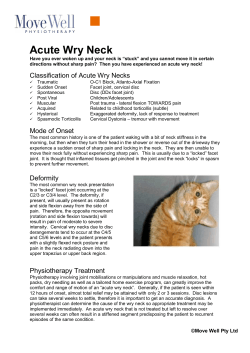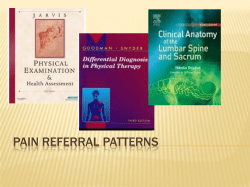
April 21, 2014 Washington State Health Care Authority 626 8th Avenue SE
American Society of Regional Anesthesia and Pain Medicine 239 Fourth Avenue ▪ Suite 1714 ▪ Pittsburgh PA 15222 +1 412-471-2718 ▪ Fax 412-471-7503 www.asra.com April 21, 2014 Washington State Health Care Authority 626 8th Avenue SE Olympia, WA 98501 SUBMITTED VIA EMAIL TO: SHTAP@hcA.WA.GOV Dear Health Technology Clinical Committee: We are writing on behalf of the 4,500 members of the American Society of Regional Anesthesia and Pain Medicine (ASRA) to express our concerns regarding the recently published draft findings and decision of the Washington State Healthcare Authority Health Technology Assessment Health Technology Clinical Committee regarding facet neurotomy. ASRA represents one of the largest number of pain physicians in the country. Lumbar Facet Neurotomy 1. The decision to cover lumbar facet neurotomy is reasonable and appropriate. However, the conditions regarding its use are too limited and may limit appropriate use that will help to reduce pain, improve function and decrease time away from work. The following specific items are of concern: a. Has at least six months of continuous low back pain referable to the facet joint. ASRA Comment: Early restoration of function is critical to returning to work and functional activity. Diagnostic blocks and facet neurotomy should be considered for patients whose pain and functional limitation persists for >3 months despite conservative measures. b. There is no other pain syndrome affecting the spine. ASRA Comment: Degenerative changes that occur with age, trauma and overuse are rarely limited to a single anatomic structure and frequently involve multiple sites. Patients who meet criteria for facet neurotomy should be eligible for treatment regardless of concomitant disease in other spinal regions as part of an overall treatment plan. c. One or two joints per each intervention, with documented, clinically significant improvement in pain and/or function for six months before further neurotomy at any level. ASRA Comment: This is a reasonable approach. It is common for degenerative changes to occur bilaterally, e.g. L4-5 and L5-S1. Please clarify if treatment for bilateral facet arthropathy is covered. Cervical Facet Neurotomy 2. Regarding coverage for cervical medial branch neurotomy, there are 4 major areas of concern. a. Patient must be selected by 100% improvement in pain after each of two differential medial branch blocks, one short-acting; one long-acting. ASRA Comment: Although optimal results are reported when selecting patients with complete relief, excellent results have also been demonstrated with more traditional guidelines of patient selection. Using 50-80% pain relief, 74% of patients obtain at least 75% pain relief at 6 months (Shin 2006, Speldewinde 2011) or >50% relief at 12 month follow-up (Sapir 2001). Patients who obtain >50-80% pain relief following dual medial branch blocks demonstrated sustained relief beyond months with neurotomy. Selecting patients who only have 100% relief sets an unrealistic standard that neither has evidence in the medical literature nor allows for persistent pain that may be present from contralateral disease or associated myofascial pain. This standard will result in an inappropriate restriction in access to a valuable pain relieving technique for a large number of patients who may receive significant pain relief and functional improvement for >6-12 months. b. One joint per each intervention, with documented, clinically significant improvement in pain and/or function for six months before further neurotomy at any level. ASRA Comment: This restriction has no foundation in the medical literature and is inconsistent with the natural history of cervical facet arthropathy, which is commonly present in more than one joint. Of all the studies listed, only the Govind study restricted treatment to a single joint (C2-3 joint/third occipital nerve) and it was designed for the treatment of third occipital headache and not neck pain. All of the other studies listed and published allowed for treatment of additional levels when indicated. When involvement of more than 1 joint is present clinically, and when diagnostic blockade confirms the clinical diagnosis, then neurotomy of more than 1 cervical facet joint should be approved. In addition, it is common for disease to occur bilaterally and it should be clarified that bilateral treatment is acceptable when all other criteria are met. We agree that patients should achieve a minimum of 6-months improvement in pain and function before consideration of repeat neurotomy. c. Has at least six months of continuous neck pain referable to the facet joint. ASRA Comment: Early restoration of function is critical to returning to work and functional activity. Diagnostic blocks and facet neurotomy should be considered for patients whose pain and functional limitation persists for >3 months despite conservative measures. d. There is no other pain syndrome affecting the spine. ASRA Comment: Although less common, some patients have concomitant disease in multiple spine areas, just as patients may have pain arising from multiple joints such as the hip and the knee. Excluding patients from treatment when alternative treatments are ineffective does not target functional restoration. Patients who meet criteria for facet neurotomy should be eligible for treatment regardless of concomitant disease in other spinal regions as degenerative changes of the spine are rarely limited to a single region of the spine. Cervical Facet Neurotomy for Headache 3. Cervical Facet Neurotomy for headache is not covered. ASRA Comment: Non-coverage of neurotomy for the third occipital nerve (TON)/C2-3 facet joint is unreasonable. This treatment has demonstrated a high degree of effectiveness in several studies. Three prospective studies have demonstrated a high level of effectiveness when patients are selected with diagnostic blockade of the third occipital nerve. Govind (2003) published the results of a revised technique for percutaneous radiofrequency neurotomy for third occipital headache and found that 88% of 49 patients obtained COMPLETE relief of pain and had a successful outcome for a median duration of 217 days. Repeat neurotomy when symptoms returned again resulted in COMPLETE relief in 86% of patients. Both Barnsley (2005) and Macvicar (2012) demonstrated comparable relief, namely 60% at 44 weeks and 61%/74% respectively at 1720 months. Macvicar’s success was defined as COMPLETE relief of pain for >6 months WITH restoration of activities, return to work (if applicable) and no need for further health care visits regarding their neck pain. They also demonstrated similar response with repeat treatment. Third occipital neurotomy has demonstrated benefit providing COMPLETE pain relief in patients with pain relieved by diagnostic blockade of the TON. This is a valuable technique for the treatment of intractable headache in a subset of patients and should be approved for use. In conclusion, we recommend the following changes to the draft findings and decision on facet neurotomy: 1. General: Eligibility should be pain > 3 months duration and not responsive to conservative measures. 2. General: There should NOT be an exclusion statement for more than 1 spinal segment pain (i.e. patients may receive both cervical and lumbar neurotomy if other criteria are met). 3. Patient selection: Patients should demonstrate ≥80% relief with dual diagnostic blocks for all regions of the spine. Treatment coverage may cover 1 or 2 joints, bilaterally when indicated. 4. Third occipital neurotomy: Patients should be eligible for third occipital (C2/3) neurotomy if strict selection criteria are met for the treatment of intractable headache. On behalf of the ASRA, we appreciate the opportunity to provide feedback to the committee regarding the draft findings and decision regarding facet neurotomy. We would be happy to meet with you to provide further information or enter into discussion with the committee to develop safe and effective coverage policies related to the care of patients with spine related pain treated with facet neurotomy. Sincerely, Joseph M. Neal, MD ASRA President Professor, Department of Anesthesiology Virginia Mason Medical Center Seattle, WA 98111 Asokumar Buvanendran, MD ASRA Treasurer and Executive Committee Member Professor of Anesthesiology and Pain Medicine Rush University Medical College Chicago, IL 60612 References: Barnsley L. Percutaneous radiofrequency neurotomy for chronic neck pain: outcomes in a series of consecutive patients. Pain Medicine 2005; 6:282-286. Govind J, King W, Bailey B, Bogduk N. Radiofrequency neurotomy for the treatment of third occipital headache. J Neurol Neurosurg Psychiat 2003; 74:88-93. MacVicar J, Borowczyk JM, MacVicar AM, Loughnan B, Bogduk N. Cervical medial branch neurotomy in New Zealand. Pain Medicine 2012;13:647-654. Sapir DA, Gorup JM. Radiofrequency medial branch neurotomy in litigant and nonlitigant patients with cervical whiplash: a prospective study. Spine (Phila Pa 1976). 2001 Jun 15;26(12):E268-73. Shin WR, Kim HI, Shin DG, Shin DA. Radiofrequency neurotomy of cervical medial branches for chronic cervicobrachialgia. J Korean Med Sci. 2006 Feb;21(1):119-25. Speldewinde GC. Outcomes of percutaneous zygapophysial and sacroiliac joint neurotomy in acommunity setting. Pain Med 2011;12:209-18. Stolker RJ et al. Percutaneous facet denervation in chornic thoracic spinal pain. Acta Neurochir (Wien) 122:82-90, 1993
© Copyright 2025











